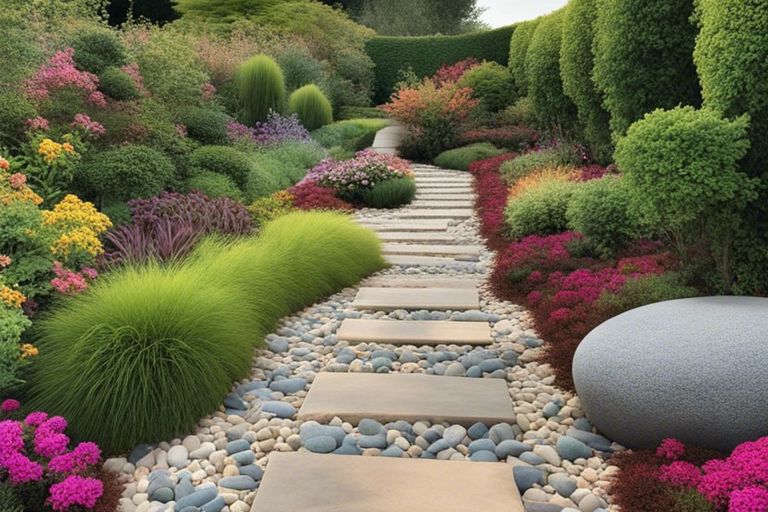Many gardeners are discovering the transformative power of black stone variety in their landscapes. This versatile material can add elegance and depth to any outdoor space while complementing a variety of plants and designs. By following these five expert steps, you can create a stunning visual impact that enhances your property’s value and curb appeal. Whether you’re aiming for a modern aesthetic or a classic feel, incorporating black stone can help you achieve the landscape of your dreams.
Key Takeaways:
- Selection: Choose the right black stone variety that complements your outdoor aesthetic and local climate.
- Design: Incorporate black stone strategically in hardscaping features like paths, patios, and borders to create contrast and visual interest.
- Maintenance: Regularly maintain your black stone landscape to preserve its appearance and longevity through appropriate cleaning and care techniques.
Selecting the Right Black Stone
The choice of black stone can greatly enhance the aesthetic and functional attributes of your landscape. By selecting the right type and ensuring suitable factors align with your vision, you can achieve a stunning outdoor environment. Understanding the variety available and considering critical aspects in your selection process will lead you to make informed decisions that elevate your landscaping.
Types of Black Stone for Landscaping
One key aspect to consider is the variety of black stones available, each bringing unique characteristics to your landscape. Below is a breakdown of common types you may encounter:
| 1. Basalt | A dense volcanic rock that’s ideal for paving and decorative aggregates. |
| 2. Slate | A metamorphic rock offering a range of colors, ideal for patios and pathways. |
| 3. Granite | A durable stone perfect for steps and edging, known for its speckled appearance. |
| 4. River Rock | Smooth, rounded stones often used for ground cover or water features. |
| 5. Schist | A metamorphic rock available in large slabs for creating striking retaining walls. |
After identifying the type that aligns with your project’s aesthetic, consider additional factors that may impact your choice.
Factors to Consider When Choosing Black Stone
Types of black stone can alter not only the appearance but also the practicality of your landscaping. When making your selection, keep the following elements in mind:
- Durability – Ensure the stone can withstand weather elements and usage.
- Size and Shape – Choose stones that fit seamlessly into your design.
- Color Consistency – Select stones that maintain uniformity for a polished look.
- Cost – Determine your budget to avoid overspending.
- Availability – Make sure the stone type you want can be sourced easily.
The right choice will not only enhance your landscape’s beauty but also its functionality. You must consider your overall design theme, maintenance needs, and budget when making your selection.
This is where understanding the specific qualities of black stones becomes vital. The most suitable stone will depend on its functionality within your landscape design, including its aesthetic appeal and lasting durability.
- Maintenance Requirements – Some stones require more upkeep than others.
- Aesthetic Match – Ensure the stone complements your existing landscaping elements.
- Installation Method – Consider how the stone will be placed and what tools may be necessary.
- Environmental Impact – Opt for stones that are sustainably sourced if possible.
- Price Stability – Research price trends to avoid sudden increases.
The ideal choice of black stone will reflect not just your taste but also enhance the overall integrity and beauty of your landscape.
Preparing the Site
Little do many realize, the key to a successful landscape enhancement begins with the meticulous preparation of your site. Understanding the land you are working with, its contours, and existing features will lay the foundation for a project that not only meets your aesthetic goals but also endures through the seasons. Taking the time to prepare your site properly will save you time, effort, and potentially costly mistakes down the line.
Assessing the Landscape Conditions
To successfully enhance your landscape with black stone, first, you must assess the existing conditions carefully. Walk around your yard and take note of the sun exposure, soil type, drainage patterns, and potential obstacles such as tree roots and underground utilities. This evaluation will guide your design choices and help ensure the longevity of your improvements. Additionally, understanding the climate and weather patterns in your area can play a crucial role in determining which stones and plants will thrive in your updated landscape.
Clearing the Area of Debris and Vegetation
Area preparation requires removing any debris, weeds, and unwanted vegetation that may obstruct your vision or future landscaping efforts. A clean slate not only makes it easier to work but also improves the aesthetic appeal of your space. Start by clearing out any rocks, organic waste, or litter. This process will create a safe working environment and allow you to accurately visualize the layout of your new landscape features.
Preparing the area adequately is vital to achieving that desired look with black stone. Taking the time to remove larger plants or shrubs, as well as any debris, will help you avoid potential hazards and ensure that the ground is level for installation. Be sure to use appropriate tools, such as a shovel or garden hoe, to avoid injury. If necessary, you may need to dig deeper to remove stubborn roots or rocks that could interfere with the placement of your new features. Effective clearing not only enhances the visual appeal but also contributes to the landscape’s long-term sustainability.
Designing with Black Stone
Not only does black stone add a striking visual element to your landscape, but it also provides versatility that can accentuate various design styles. Its rich hues and textures bring depth to gardens and outdoor spaces, allowing you to create stunning visual contrasts with greenery and other materials. By utilizing black stone thoughtfully, you can create a cohesive aesthetic that enhances your overall outdoor experience.
Creating a Focal Point with Black Stone
One of the most effective ways to integrate black stone into your landscape design is by creating a focal point. Whether it’s a bold black stone water feature, an eye-catching sculpture, or a carefully arranged rock garden, placing black stone strategically can draw attention and anchor your space. This focal point not only serves as a visual centerpiece but also invites exploration and curiosity, encouraging visitors to engage more deeply with your garden.
Additionally, consider the use of contrasting elements around your black stone focal point. For instance, pairing it with brightly colored flowers or lush greenery can enhance its dramatic impact. By surrounding your focal point with vibrant colors and natural textures, you create a sense of balance and harmony that complements the boldness of the black stone.
Balancing Black Stone with Other Hardscape Materials
Hardscape elements are necessary in landscape design, and when incorporating black stone, it’s crucial to create balance among various materials. Mixing black stone with lighter stones, timber, or concrete can result in a visually appealing contrast that highlights the unique qualities of each material. This balance not only enriches your landscape’s overall appearance but also ensures that the black stone does not overwhelm the surrounding environment.
Stone accents can be effectively introduced through borders, pathways, or retaining walls that guide the eye while allowing other elements to shine. By ensuring that the proportions and colors of your hardscape materials complement each other, you can achieve a more integrated and cohesive outdoor environment.
Considering the Scale and Proportion of Black Stone Features
Black stone can be a bold choice, so it’s important to consider scale and proportion in your design. Make sure that the size of your black stone features corresponds well with the surrounding landscape elements. Oversized features can dominate a smaller space, while too-small stones may get lost in a vast garden, leading to a disjointed appearance. Take time to measure and visualize how the black stone interacts with other aspects in your landscape, ensuring a harmonious flow throughout your outdoor space.
Stone sizes, shapes, and arrangements also play an necessary role in achieving the desired aesthetic. You might choose to use large slabs for pathways or walls, while smaller pebbles can be sprinkled throughout garden beds for texture. This thoughtful approach to scale will create a landscape that feels intentional and harmonious, ensuring that your use of black stone enhances your overall design instead of detracting from it.
Laying the Black Stone
Your landscape can be significantly enhanced by incorporating black stone, providing a striking contrast to greenery and adding an element of sophistication. Understanding how to properly lay these stones can make all the difference in achieving a polished, professional look. For visual inspiration and practical tips, check out How to Use Rocks in Your Landscape, which showcases diverse applications of stone in various outdoor settings.
Excavating and Grading the Site
Stone installation starts with proper site preparation, which involves excavating the area where you plan to lay the black stone. Begin by marking the dimensions of your project with stakes and string, ensuring you have a clear layout. Next, remove any grass, foliage, or debris, followed by excavating to a depth that allows for your chosen stone thickness plus an additional layer of gravel beneath. Grading the surface is critical; the area should slope gently away from any structures to prevent water pooling in your landscape.
After grading, compact the soil to create a stable base. If you’re working with pavers or tiles, consider using a plate compactor for a more uniform surface. Pay attention to any uneven spots, as this can lead to complications down the line, such as lifting or settling of your black stone, which can ruin the aesthetic you strive to achieve.
Laying the Black Stone Pavers or Tiles
Stone pavers or tiles are a wonderful addition to your landscape when laid correctly. Using your prepared site, start by applying an even layer of sand or gravel as a bedding material. This helps to keep the stones level and allows for easy drainage. Lay out the black stones in your desired pattern, beginning from a corner or edge and working your way across. If you’re using tiles, ensure you use a tile spacers for consistent gaps, permitting room for expansion and contraction.
This process is not only about *placement*. You might need to gently tap the stones in place with a rubber mallet to ensure they are level and firm, giving a professional finish. A tighter fit results in an aesthetically pleasing layout that enhances the overall look of your landscape.
Ensuring Proper Drainage and Water Flow
Drainage is a significant factor to consider when laying black stone. Adequate water flow ensures that your landscape remains healthy and your stones do not become muddied or displaced over time. Ensure that the ground beneath your stones is properly compacted and sloped to facilitate water runoff. If your area has heavy rainfall or poor drainage, consider incorporating drainage systems such as french drains to control water flow effectively.
By configuring the site to allow for proper drainage, you not only maintain the beauty of your landscape but also extend the life of your black stone installation. A well-drained area prevents erosion and mud from creeping into your project, preserving the visual integrity of your work.
Pavers positioned strategically also aid in swift water movement, creating a functional environment. Recall, proper drainage means fewer worries about maintenance and damage, allowing you to enjoy your stunning landscape for years to come!

Adding Finishing Touches
All thoughtful landscaping designs deserve a little extra flair, and the finishing touches can make all the difference in enhancing your garden’s overall appeal. Whether you are highlighting the intricate details of your black stone features or incorporating harmonious elements that tie your landscape together, the right choices can elevate your outdoor space to new heights. With just a few expert steps, you can transform your garden into a serene haven that reflects your personality and style.
Incorporating Lighting to Highlight Black Stone Features
Stone features, especially when constructed from a striking black stone variety, can truly shine when illuminated strategically. By employing soft outdoor lighting, you can create captivating shadows and highlights that accentuate the unique textures and colors of your stone installations. Consider using pathway lights, spotlights, or even solar-powered accents to draw attention to your black stone features during nighttime hours. This not only enhances the aesthetics but also adds a layer of safety and functionality to your landscape.
Moreover, positioning your lighting in a way that casts gentle silhouettes against the surrounding greenery can generate a peaceful ambiance, making your outdoor space inviting for evening gatherings or quiet reflection. Layering your lighting sources—using both uplights and downlights—will allow for a more dynamic effect, ensuring that every angle of your black stone features is beautifully showcased.
Planting Ground Covers and Ornamental Plants
Adding a selection of ground covers and ornamental plants around your black stone features can create a stunning contrast, enhancing the overall visual interest of your landscape. By choosing plants with varying heights, colors, and textures, you ensure a seamless blend that complements your stone installations. Plants like creeping thyme or mondo grass work well as ground covers, while ornamental grasses and flowering plants like hydrangeas can provide structure and vibrancy.
Ornamental plants not only offer practical benefits, such as helping with erosion control and providing habitat for beneficial insects, but they also lend a sense of structure and formality to your garden. Depending on the climate and layout of your space, consider mixing seasonal flowers to keep your landscape vibrant all year long. Utilizing ground covers and ornamental plants can contribute to a lush and detailed environment that plays beautifully off the sleek elegance of black stone.
Adding Decorative Elements and Accessories
Any landscape can be taken to the next level by thoughtfully incorporating decorative elements and accessories. From elegant statuary and striking planters to charming seating areas or eye-catching water features, these details add your personal touch and enhance your outdoor experience. When choosing accessories, ensure they resonate with the style and color palette of your black stone features, bringing a harmonious look to your landscape.
Another important aspect to consider is the placement of these decorative elements. They should not only enhance the visual appeal but also work well with the existing layout of your garden. Ensuring that they do not overcrowd or distract from your main features is vital; after all, the goal is to create a balanced and inviting space that reflects your unique style. With these finishing touches, your landscape will come alive, ready for you to enjoy and show off to guests.
Maintenance and Upkeep
Once again, the beauty and elegance of black stone in your landscape can shine through with the right maintenance and upkeep practices. Your stunning installations require regular attention to keep them looking their best, ensuring they remain not only functional but also aesthetically pleasing year-round.
Cleaning and Sealing Black Stone Surfaces
Surfaces crafted from black stone can develop a layer of grime and dirt over time, diminishing their natural luster. To maintain the striking appearance of your black stone, regular cleaning is imperative. This usually entails rinsing with water to eliminate loose debris, followed by scrubbing with a manufacturer-approved cleaner to remove any stubborn stains. Aim to perform this cleaning at least once or twice a year to prevent buildup. Afterward, sealing the stone can enhance its resistance against UV rays, moisture, and occasional spills, safeguarding your investment for years to come.
Preventing Weeds and Erosion
To maintain the pristine appearance of your black stone landscape, effective weed and erosion management is crucial. Regularly check the joints and crevices of your stone installations for any signs of weed growth. Immediate removal of these intruders prevents them from taking root, which can lead to further complications in your landscape. Additionally, consider using landscape fabric or gravel as a barrier. This will keep unwanted plants at bay while allowing water to permeate the soil, maintaining the health of your garden.
A well-planned strategy for erosion control can further protect your landscape. Incorporating ground cover plants within your stone pathways helps stabilize the soil and absorbs excess rainwater, preventing washout. Maintaining good drainage around your black stone features is also key, as stagnant water can lead to long-term deterioration.
Seasonal Maintenance Tasks
Weeds, dirt, and the elements will challenge the beauty of your black stone throughout the different seasons. As the seasons change, your maintenance tasks should adapt accordingly. In spring, focus on clearing debris from your stone surfaces, while summer may require more frequent cleanings due to increased usage. As fall approaches, ensure that leaves and organic matter do not settle on your black stone, as they can contribute to staining and erosion. Winter will call for a different approach, where ice-melting products are carefully chosen to protect the integrity of your stones.
Understanding these seasonal variations will allow you to anticipate and prepare for the maintenance needs of your black stone landscape. By staying proactive and attentive, you can ensure that your outdoor space remains stunningly beautiful, resilient, and inviting throughout the year.
Final Words
Ultimately, implementing these five expert steps to enhance your landscape with black stone variety can transform your outdoor space into a sophisticated haven. By choosing the right black stone, considering strategic placement, and thoughtfully pairing it with other elements, you elevate not just the aesthetic appeal of your garden but also its functionality and longevity. Be mindful of, every stone tells a story, and as you curate your landscape, you create a unique narrative that reflects your personal style and vision.
As you commence on this journey, don’t hesitate to experiment and let your creativity shine through. Nature offers a canvas, and the striking contrast of black stone against vibrant foliage or soothing water features can result in truly breathtaking compositions. Invest the time to explore various designs and approaches, and you’ll find that enhancing your landscape with black stone variety is not merely a task; it’s a delightful expression of art and nature harmoniously intertwined.
FAQ
Q: What are the benefits of using black stones in my landscape design?
A: Black stones not only provide a striking visual contrast against vibrant plants and greens, but they also offer practical benefits such as better heat retention and a unique aesthetic that can complement various design styles. Additionally, black stones can enhance soil drainage when used properly, reducing the risk of waterlogging in your garden.
Q: How do I choose the right type of black stone for my landscaping project?
A: When dicking out black stones for landscaping, consider factors such as size, texture, and intended use. For pathways, you might prefer larger, flatter stones, while smaller pebbles might be more suitable for decorative features or ground cover. It’s also important to consider the compatibility of the stone with your existing landscape elements and the overall theme you want to achieve.
Q: What are the expert steps to properly incorporate black stones into my landscape?
A: To effectively incorporate black stones into your landscape, follow these expert steps: 1) Assess your space to identify where stones can enhance your design, such as in gardens, pathways, or as a border. 2) Choose the right size and type of black stone for each specific area. 3) Combine black stones with complementary colors and materials to create a harmonious look. 4) Ensure proper drainage and soil preparation to maintain plant health. 5) Regularly maintain the area by cleaning the stones and monitoring plant growth to keep your landscape looking fresh and vibrant.


